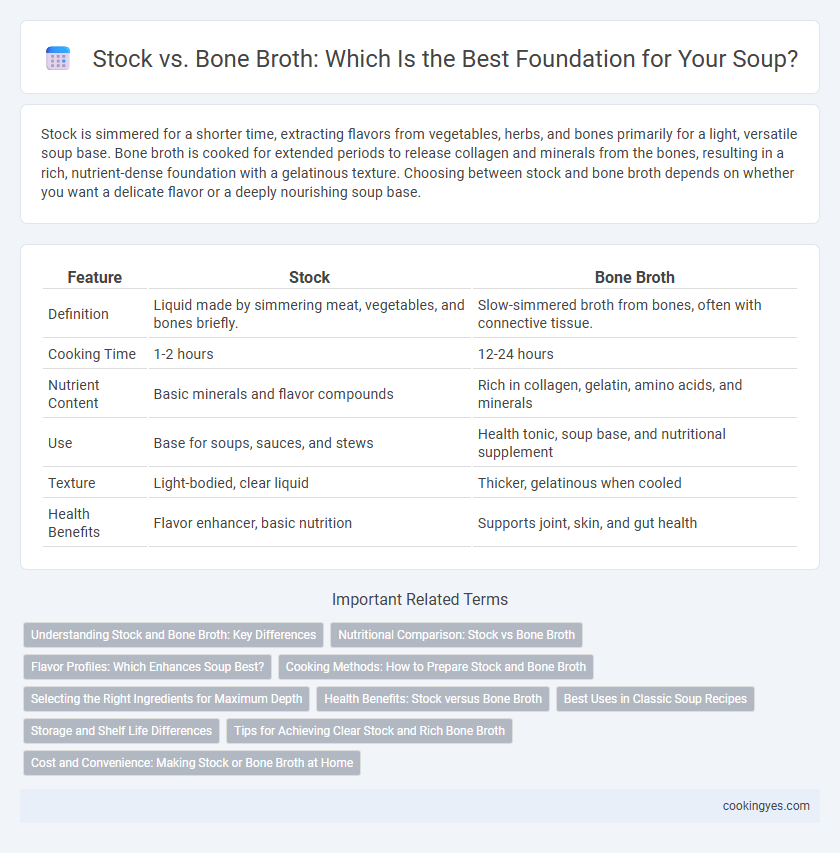Stock is simmered for a shorter time, extracting flavors from vegetables, herbs, and bones primarily for a light, versatile soup base. Bone broth is cooked for extended periods to release collagen and minerals from the bones, resulting in a rich, nutrient-dense foundation with a gelatinous texture. Choosing between stock and bone broth depends on whether you want a delicate flavor or a deeply nourishing soup base.
Table of Comparison
| Feature | Stock | Bone Broth |
|---|---|---|
| Definition | Liquid made by simmering meat, vegetables, and bones briefly. | Slow-simmered broth from bones, often with connective tissue. |
| Cooking Time | 1-2 hours | 12-24 hours |
| Nutrient Content | Basic minerals and flavor compounds | Rich in collagen, gelatin, amino acids, and minerals |
| Use | Base for soups, sauces, and stews | Health tonic, soup base, and nutritional supplement |
| Texture | Light-bodied, clear liquid | Thicker, gelatinous when cooled |
| Health Benefits | Flavor enhancer, basic nutrition | Supports joint, skin, and gut health |
Understanding Stock and Bone Broth: Key Differences
Stock is made by simmering bones, vegetables, and aromatic herbs for a shorter time, typically 4-6 hours, resulting in a thinner liquid rich in gelatin and flavor for soups. Bone broth undergoes a longer cooking process, often exceeding 12 hours, extracting collagen, minerals, and amino acids that offer added nutritional benefits and a richer, more concentrated taste. Understanding these differences helps choose the right foundation for recipes, balancing flavor intensity and health benefits.
Nutritional Comparison: Stock vs Bone Broth
Bone broth contains higher levels of collagen, amino acids, and minerals like calcium, magnesium, and phosphorus compared to traditional stock, which is primarily made from simmering meat and vegetable scraps. The extended cooking time of bone broth extracts more nutrients, supporting joint health, skin elasticity, and gut healing more effectively than regular stock. Stock offers a lighter flavor and fewer calories, making it suitable for general cooking, while bone broth serves as a nutrient-dense foundation for soups and stews.
Flavor Profiles: Which Enhances Soup Best?
Stock offers a lighter, more neutral flavor ideal for soups requiring subtlety and clarity, derived primarily from simmered vegetables, herbs, and bones over a shorter period. Bone broth provides a richer, more robust taste due to prolonged simmering of marrow-filled bones, releasing gelatin and minerals that deepen umami and mouthfeel. For soups aiming to maximize depth and heartiness, bone broth enhances complexity, while stock supports delicate, balanced flavor profiles.
Cooking Methods: How to Prepare Stock and Bone Broth
Stock is prepared by simmering bones, vegetables, and aromatics for 4-6 hours to extract flavors, resulting in a lighter, clear base ideal for soups and sauces. Bone broth requires a longer cooking time, typically 12-24 hours, to break down collagen and minerals from bones, creating a rich, gelatinous texture packed with nutrients. Both methods benefit from roasting bones beforehand to enhance depth of flavor, while careful skimming ensures clarity in the final liquid.
Selecting the Right Ingredients for Maximum Depth
Choosing the right ingredients is crucial for achieving maximum depth in soup foundations, where stock and bone broth serve distinct purposes. Stock, made primarily from simmering bones with aromatic vegetables, offers a clean, light flavor ideal for delicate soups and sauces. Bone broth, enriched by longer cooking times and often including vinegar to extract minerals, delivers a rich, gelatinous texture packed with nutrients, perfect for hearty, robust dishes.
Health Benefits: Stock versus Bone Broth
Bone broth is rich in collagen, gelatin, and minerals like calcium and magnesium, promoting joint health, skin elasticity, and gut healing. Stock, made primarily from simmered vegetables and bones, contains fewer nutrients but provides essential vitamins and a lighter flavor suitable for daily cooking. Both offer hydration and nutrients, but bone broth delivers superior concentration of health-boosting compounds beneficial for inflammation and digestion.
Best Uses in Classic Soup Recipes
Stock provides a lighter, more neutral base ideal for clear soups, consommes, and delicate vegetable soups, enhancing flavors without overpowering them. Bone broth offers a richer, gelatinous texture packed with collagen, making it perfect for hearty stews, creamy bisques, and slow-cooked recipes requiring depth and mouthfeel. Classic chicken noodle soup benefits from stock's subtlety, while bone broth elevates beef stew and French onion soup with robust body and nutritional value.
Storage and Shelf Life Differences
Stock typically offers a shorter shelf life, lasting about 4 to 5 days in the refrigerator, while bone broth can last up to 7 days due to its higher collagen and mineral content that acts as a natural preservative. Freezing extends the storage time for both, with stock and bone broth maintaining quality for 4 to 6 months when stored properly in airtight containers. Bone broth's gel-like texture after refrigeration indicates a rich collagen presence, which contributes to its prolonged freshness compared to the thinner consistency of stock.
Tips for Achieving Clear Stock and Rich Bone Broth
To achieve a clear stock, use cold water and gently simmer bones with vegetables, avoiding rapid boiling that causes cloudiness. For rich bone broth, roast bones beforehand to enhance flavor and simmer for at least 12 hours to extract maximum collagen and minerals. Skimming impurities regularly during cooking ensures clarity while prolonged cooking develops depth and nutrient density.
Cost and Convenience: Making Stock or Bone Broth at Home
Stock is generally more cost-effective and faster to make at home, using inexpensive cuts of meat and vegetable scraps, simmered for a few hours. Bone broth requires longer cooking times, often 12-24 hours, to extract collagen and minerals, increasing energy costs and effort. For convenience and budget-friendly soup foundations, stock offers a practical solution, while bone broth provides richer nutrients but demands more time and resources.
Stock vs Bone Broth for Foundation Infographic

 cookingyes.com
cookingyes.com